[subpages]
hist
Art Exhibitions

Can the art of Burning Man be taken out of its playa context and successfully presented in a museum setting? The answer is a resounding “Yes!” Using photographs and videos for context, large scale sculpture, material culture, mutant vehicles, jewelry, and costumes have been shown to the public beyond Burning Man, spreading our ethos even further out into the world.
Burning Man has presented three art exhibitions since 1998: two featuring art installations, photographs, and video, and one focusing on neon. From a curatorial point of view, showing Burning Man art can be difficult, as many of the installations created on the playa have been burned and are available to us only in photographs, and the scale of much of the work is prohibitive. However, we’ve managed to show actual art from the playa as well as other work our artists have created.
 Our first exhibit was The Art of Burning Man at the San Francisco Art Commission Gallery, July 29 to August 29 1998. The second was an updated version of The Art of Burning Man at Theater Bruka in Reno, July 9 to 31, 1999. Our third exhibit, at the Museum of Neon Art in Los Angeles, took place from December 11, 1999 through March 12, 2000 and was curated by LadyBee.
Our first exhibit was The Art of Burning Man at the San Francisco Art Commission Gallery, July 29 to August 29 1998. The second was an updated version of The Art of Burning Man at Theater Bruka in Reno, July 9 to 31, 1999. Our third exhibit, at the Museum of Neon Art in Los Angeles, took place from December 11, 1999 through March 12, 2000 and was curated by LadyBee.
In addition, six independent arts organizations have staged exhibitions of Burning Man art. In the summer of 2001, the Sonoma Museum of Visual Art showed six large-scale outdoor sculptures, and in 2007, the Nevada Museum of Art in Reno showed A Tribe of Artists: Costumes and Culture of Burning Man, Geoffrey Nelson’s photographs and costumed mannequins.
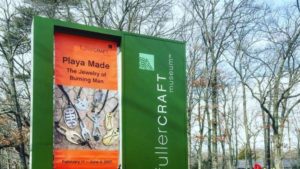
In 2017, three museum shows took place:
Playa Made: Jewelry of Burning Man, guest curated by LadyBee and based on the book of the same name, debuted at the Fuller Craft Museum in Brockton, Massachusetts; this exhibit was shown from February 11 through June 4, 2017. WBUR, Boston’s NPR affiliate, nicely reviewed the exhibit.

Virginia’s Hermitage Museum showed Burning Man art from June 3 through October 14.The concept for the show originated with the Hermitage’s Executive Director Jen Duncan in 2015. “I think that Burning Man is an incredibly powerful way for people with shared passions to connect whether it’s through art, music, religion, or other ideas,” Duncan said. “The festival removes any barrier from the experience, makes it more interactive, with fewer rules constraining the visitor and the artist. The art created at Burning Man is only available for a limited time each year, and I believe that it can stand on its own and should be displayed in the museum setting as well.” Read more about it in the Burning Man Journal and in the Virginian Pilot.

The Nevada Museum of Art showed its archival exhibit, City of Dust, The Evolution of Burning Man from July 1, 2017 through January 7, 2018. The show grew out of Danger Ranger’s gift of his extensive personal archives to the NMA’s Center for Art and Environment, where curators William Fox and Anne Wolfe developed the exhibit, working with Burning Man. They created a documentary, and several Burning Man staff members delivered presentations on the art and culture of Burning Man. We were also featured in the Center’s annual conference, Art and Environment, October 19-21, 2017. The exhibit was reviewed in Moonshine Ink.
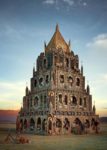
In 2018, part of the NMA exhibit travelled to the Smithsonian in Washington D.C. as part of the Renwick Gallery’s major exhibit, No Spectators: The Art of Burning Man. Opening on March 30, 2018, this important exhibit explores the art, mutant vehicles, jewelry, costumes and photography of Burning Man, as well as our history and ethos; the Renwick’s curator Nora Atkinson worked closely with Burning Man to develop the exhibit. In addition, six sculptures from the playa will be shown throughout the surrounding neighborhood in an outdoor extension of the exhibit, No Spectators: Beyond the Renwick. Programming includes a gala opening, a “Meet the Artists” event in the galleries, and presentations by several staff members.
Polls Archive
Each year Black Rock City is raised from the surface of the desert as a result of the cooperation and participation of many. It is only by combining our collective efforts that we can create the experience that is Burning Man. As such, we invite and encourage the input and opinions of our participants about a wide variety of issues related to Burning Man.
From 2003-2008, we gathered participant input through polls. Now that there are so many other mechanisms for expressing opinions, we discontinued polling. We may start again in the future, who knows. Here are the polls we ran:
2008 ARCHIVED POLLS
| What did you think of the size of Black Rock City in 2008? | |||||||||||
|
June 12, 2008 to August 12, 2008
| What do you think of the new Burning Blog? | |||||||||
|
March 11, 2008 to May 11, 2008
| Did the Green Man theme inspire you to green your day-to-day life? | |||||||||||
|
2007 ARCHIVED POLLS
| What did you think of Burning Man 2007? | |||||||||||
|
December 28, 2006 to January 28, 2007
| When do you start planning your theme camp? | |||||||||||||
|
2006 ARCHIVED POLLS
| What did you think of Burning Man 2006? | |||||||||||
|
July 19 to August 19, 2006
| How do you light your art, rebar and bike on the playa? | |||||||||||||
|
February 26 to March 26, 2006
| When do you register your theme camp, art installation or mutant vehicle? | |||||||||||
|
2005 ARCHIVED POLLS
| How do you feel about the 2006 Art Theme “Hope and Fear: The Future”? | |||||||||
|
October 26 to November 26, 2005
| What did you think of Burning Man 2005? | |||||||||||
|
September 22 to October 22, 2005
| How do you connect with fellow Burners after the event? | |||||||||||||
|
July 14 to August 14, 2005
| What do you do with the Survival Guide? | |||||||||||
|
May 6 to June 6, 2005
| What do you think of the new Black Rock City Plan? | |||||||||||||
|
April 5 to May 5, 2005
| When do you visit theme camps? | |||||||||||||||
|
February 16 to March 16, 2005
| How do you read the JRS? | |||||||||||||||||||
|
December 29, 2004 to January 31, 2005
| What day of the year do you consider the beginning of your “new year”? | |||||||||||||
|
2004 ARCHIVED POLLS
December 2 to December 23, 2004
August 2 to August 23, 2004
July 12 to July 26, 2004
May 20 to June 10, 2004
April 6 to April 27, 2004
Feb 26 to March 11, 2004
Jan 27 to Feb 26, 2004
2003 ARCHIVED POLLS
|
|||||||||||||||||||||||||||||||||||||||||||||||||||||||||||||||||||||||||||||||||||||||||||||||||||||||||||||||||||||||||||||||||||||||||||||||||||||||||||||||||||||||||||||||||||||||||||||||||||||||||||||||||||||||||||||||||||||||||||||||||||||||||||||||||||||||||||||||||||||||||||||
Evolution of Black Rock City
You can learn about the urban planning and design that went into the evolution of Black Rock City, home to the people of Burning Man, in Metropol, the blog series created as part of the Burning Man 2010 art theme “Metropolis: The Life of Cities”.
You can also read the Building Black Rock City series, which chronicles each year’s process of building the infrastructure for our ephemeral desert metropolis.
Playa Artifacts Archive
Welcome to the fascinating world of material culture. The artifacts and gifts that people give one another at Burning Man reveal a great deal about themselves and give us information on ways of life, spiritual values and customs, which are not recorded elsewhere.
Gift-giving on the playa joins creative expression with delighted acceptance. These objects are often given spontaneously for the pleasure of giving and receiving. We delight in the charm of a 2-inch man made from one piece of copper wire and puzzle over the meaning of a playing card chosen and handed to you by a citizen in passing.
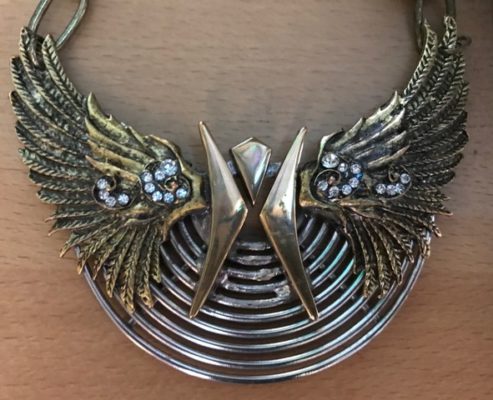
Sometimes they are given for utilitarian reasons: to thank somebody for a drink of water or a pretty little bag to help collect MOOP (Matter Out of Place). Burning Man seems to inspire the urge to create and give, and anyone inclined to make a gift generally experiences an appreciative reception.
Burning Man’s repository of playa gifts has grown to include such ephemera as stickers, decals, stamped coins, temporary tattoos, buttons, trading cards, cigarette lighters, embroidered patches, postcards, notepads, photocopied booklets and matchbooks.
It also contains arts and crafts, including silk-screened prints, T-shirts, stamps, etchings, silver charms, blown-glass pendants, medallions and small boxes of ashes collected from the Man burn.
Not all of the objects Burning man collects are mass-made playa gifts. Some are one-of-a-kind artworks. Some are artifacts from events, theme camps and art installations. Others are mementos given to volunteers in the various departments.
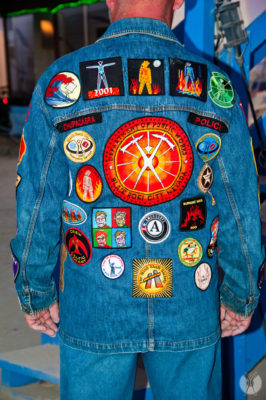
To add to our archives, please download and fill out our Playa Artifacts PDF form. Make sure you include the year the object was made.
On the playa, bring the form and the Playa Artifacts to the ARTery in Center Camp where we provide you with a sealed bag to store your contribution. We also have forms for you to fill out if you didn’t bring one with you.
Off the playa, mail this form and your Playa Artifacts to:
Material Culture
c/o Burning Man
P.O. Box 884688
SF, CA
94188-4688
You can also submit a JPG image of your playa artifacts to our online Material Culture Archives. You can search the Gallery by types of artifacts: pendants, patches, stickers, etc. Please send the artifacts and form to us for our office archives as well. These objects are displayed at the Burning Man office and will be used for future exhibitions.
Please send any questions or comments about the artifacts to material-culture@burningman.org. Thank you!
MOOP Map Archive
Burning Man is the largest Leave No Trace event in the world, and Black Rock City continues to be recognized by the Bureau of Land Management for not only maintaining Leave No Trace standards, but for setting high standards by which other recreation events are measured. And that wouldn’t be possible without the concerted efforts of Burning Man participants who pick up after themselves (and others).
The MOOP Map is Burning Man’s Leave No Trace record for each year. It reflects what the Department of Public Works’ Playa Restoration Team found (and removed) when they conducted their post-event sweep of the Black Rock City event site, ultimately returning the playa to its pristine condition.
AfterBurn Reports
The AfterBurn Report is an annual year-end report which provides Burning Man participants, the media, and the public at large with an up-to-date overview of Burning Man Project and Black Rock City operations, our objectives, and the obstacles we encounter. Our hope is that this report will help provide a context for understanding the organization and the people behind the event. “Burning Man” is the name we use to define the scope, scale and dynamic nature of what we all do together.
Burning Man Project includes a full-time staff, a larger group of part-time seasonal staff, and thousands of event staff (both paid and volunteer) as well as participants who take responsibility for making Burning Man happen. The AfterBurn Report explains what our various departments do, why they do it, what changes occur year to year, where Burning Man Project’s money goes, our successes and failures, and our vision for the future.
Census Archive
The Census is one of the primary ways the Burning Man organization tracks changes in population, behavior, and attitudes of event participants. The more we understand the makeup of Black Rock City and the diverse kinds of Burning Man experiences, the better equipped we are to meet the needs of the community and help Burning Man culture continue to flourish.
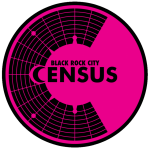 Data from the Census also helps the organization represent the Burner community in conversations with local, state and federal agencies and elected officials. Census data is also used to understand the impact we have on the environment. Ultimately, we want to reduce our carbon footprint and make the event more sustainable. In the last few years, the Burning Man organization has rolled out several programs (like Burner Express) to encourage these efforts and the Census is one way that we track the year-to-year impact of those measures with information like the number of vehicles on the road, the number of people per vehicle and the increased use of the Burner Express.
Data from the Census also helps the organization represent the Burner community in conversations with local, state and federal agencies and elected officials. Census data is also used to understand the impact we have on the environment. Ultimately, we want to reduce our carbon footprint and make the event more sustainable. In the last few years, the Burning Man organization has rolled out several programs (like Burner Express) to encourage these efforts and the Census is one way that we track the year-to-year impact of those measures with information like the number of vehicles on the road, the number of people per vehicle and the increased use of the Burner Express.
More importantly, however, the Census is about YOU. This is your chance to have your presence in BRC counted and to learn about our community. It gives Burners the ability to understand just a bit more about the city that many of us call home. It is a chance for us all to learn who our neighbors might be, what brings them out to Burning Man, and what changes are taking place in BRC from one year to the next. Learn more about how the data is collected and analyzed or how to join the volunteer team, and then check out the Census results through the years:
2022 Census
2022 Population Analysis (PDF)
2019 Census
2019 Population Analysis (PDF)
2018 Census
2018 Population Analysis (PDF, 4MB)
2017 Census
2017 Summary Report (PDF, 8 MB)
2017 Population Analysis (PDF, 25 MB)
2016 Census
2016 AfterBurn Report (PDF, 20 MB)
2016 Annual Population Analysis (PDF, 49 MB)
2015 Census
2015 AfterBurn Report (PDF, 2.6 MB)
2015 Expanded Census Report (PDF, 5.2 MB)
2014 Census
2013 Census
2012 Census
2011 Census
2010 Census
2009 Census
2008 Census
2006 Census
2007 Census
2005 Census
*No surveys were taken in the years 2002 through 2004
2001 Survey
Annual Event Archives
Here you will find links that will take you on a trip through the past — through the history of Burning Man — from its early days on a small beach in San Francisco through its evolution into the bustling temporary metropolis of 70,000+ people and sprawling diaspora that Burning Man has become today. Indeed, Burning Man has grown from a small group of people gathering spontaneously to a community of over a million people.
It is impossible to truly understand the event as it is now without understanding how it has evolved. For a high-level overview of each year, see our Historical Timeline.
For more details, look through the archives for each year, starting with Burning Man 1986-1996 for the legendary story of Burning Man’s beginnings. These archives contain descriptions of each year’s art theme, theme camps, large art installations, as well as maps, journals of our city being built, the newsletters to the community, issues of the Black Rock Gazette (a daily news publication that was produced and printed on the playa), and clean up reports for each year.
These archives represent the history of not only our event, but our community and our culture, as they are one in the same.
Historical Publications
 In Burning Man’s pre-Internet years, the community relied on printed communications to stay connected. These early publications contain some of the first essays on the emerging culture and philosophy, and provide some intriguing insights into Burning Man’s evolution.
In Burning Man’s pre-Internet years, the community relied on printed communications to stay connected. These early publications contain some of the first essays on the emerging culture and philosophy, and provide some intriguing insights into Burning Man’s evolution.
Building Burning Man
Published from 1991-1999, this newsletter was a primary means of connecting the community between Burns. Its pages feature some seminal writing on the event and the culture from Larry Harvey, Stuart Mangrum, Louis Brill, Erik Davis, and other early observers, including the mysterious Darryl VanRhey (hint: it’s an anagram).
Black Rock Gazette
Founded by Danger Ranger in 1992, Black Rock City’s first daily newspaper was published onsite during the event until 2005. Occasionally informative, frequently absurd, its wry humor was rooted in the prankster culture of the Cacophony Society and the outsider spirit of ‘zine culture.
Burning Man Journal
In 2000 the Building Burning Man newsletter morphed into a glossy four-color magazine with an emphasis on art and culture. Its wider coverage also facilitated discussions of post-event issues like playa restoration and helped launch the Regional Network.
Tip Sheets
Starting in 2007, when the population of Black Rock City started to outstrip its ability to communicate culture across the broad expanse of its citizenry, Burning Man began creating “Tip Sheets” to provide key information to participants, whether they be newbies or multi-year veterans. They are handed out at the Greeters Station, to educate people about the ins and outs of being a citizen of Black Rock City.
Burning Man Art in the 1990s
A conversation with Larry Harvey by Darryl Van Rhey (1997)
Darryl Van Rhey: The system that has supported Art in America appears to have reached a crisis; patronage is disappearing, galleries are closing, even the NEA is under siege. Yet Burning Man has grown into a large-scale venue for new art. Why is this?
Larry Harvey: Well, I think you’re right. The folks upstream have raised their dams. The old patronage system, like so many other hierarchies in American life, is breaking down. Artists are perennial have-nots. I don’t think they can expect much in the future, but this may be a blessing in disguise.
DVR: Why?
LH: Because the old system doesn’t work. Artists are trapped. Very little money goes directly to creators. Most grant funding goes to institutions. From there it trickles down in little dribs and drabs. This has the effect of isolating artists. For one thing, it isolates them from their audience. It’s one thing to delight ordinary people with your work, quite another to “delight” a board of directors. Committees aren’t creative and bureaucracies haven’t a delightful bone in their bodies. Institutions, supposedly designed to disseminate art, often become the real clients. There are political tests, peer reviews, and the ever-present lust for institutional prestige. I’m not saying some deserving work doesn’t get funded, but grants and gallery berths are always in short supply. And this, in turn, leads to a second form of isolation. Artists are competing for scarce resources and this isolates them from one another. Everyone is desperate for individual distinction — “Choose me! Choose me!’. It creates a kind of mania. All over the South of Market district in San Francisco artists are waking up at 3 AM, covered with flop sweat, thinking, “Oh my God! What if I’m derivative?”. This is not a creative climate. Collaboration is the soul of culture, but the system divides people.
DVR: What is the alternative?
LH: Populism; an art that is immediately available to large numbers of people. Nothing’s going to trickle down. It’s time for artists to spread out. We need a broader public.
DVR: What are the characteristics of populist art?
LH: It is immediate and involving. It’s collaborative and it breaks down barriers between audience and art work. It’s based upon participation — it’s radically interactive — and it contemplates the facts of life. I’ll give you an example. Last year Ray Cerino created a public shower for us in the desert. He called it “Water Woman”. A stream of water spouted from between its legs. The piece itself was very elegant, but, beyond any question of form, it required an action. It was grounded in need. It was based on survival. People got naked — it was fun and it was funny. Another example is Pepe Ozan. Pepe’s based in San Francisco and he leads a troupe of sculptors. During three successive years they have created large-scale towers — hollow columns, chimneys, really — which they craft from rebar, metal mesh and mud. Last year’s lingam, as it’s called, was three stories tall. Pepe’s work is quite sensuous, very tactile, plastic, elaborately formed. Under any circumstances this would constitute a significant achievement. But to stop at the completed product is to miss the point. On Saturday night they filled the tower with firewood. It glowed like molten magma, spouted fireworks, and an elaborate operatic performance ensued. Moreover, more than five thousand people, many of them costumed or painted with mud, gathered around it to celebrate. The point I’m making is this: populist art, the kind of art we’re creating, convenes society around itself. This goes far beyond the concept of an exhibition. We see thousands of people who normally wouldn’t go near a gallery. And this is true for artists also. We give them a community in which to meet and work collaboratively with hundreds of other creators, and with a freedom and at a scale that they can find in no other place.
DVR: What can you tell me about the content of the art your project has generated?
LH: We dictate nothing to the individual creator. However, every year we create a theme. Last year our motif was Hell; the premise being that a supra-national conglomerate called “HELCO” was attempting to purchase the Project. It did a very brisk business in souls. We actually created a uniformed sales force that recruited customers. A sculptor, Al Honig, created a sucking device which extracted and processed people’s souls, and we transferred this theme to the desert in the form of a huge walk-through installation that was spread out over a quarter mile. This included a four story complex — HELCO’s world headquarters — which we eventually burned to the ground. HELCO sank into insolvency.
DVR: So the work was satirical?
LH: Satirical and satanic; the best of both worlds. This year we will satirize the New Age. We plan to stage earth and fertility rites. My favorite so far is Cruel Mistress Gaia — Mother Earth meets Venus in leather. She’ll be served by a court of very subservient vegetables. It will be funny, unnerving and weird, but, as with any good joke, we also have a very serious intention. We use our shows to create collective stories, myths which dramatize the life of our community. This year we’ll be moving to a new site; land on the edge of a smaller playa. We’re founding a new home, so some serious earth magic seems in order.
DVR: Can you elaborate on this concept of art as myth?
LH: Sure. It’s part of giving art a greater social function. Quite obviously though, since we’re not members of a pre-literate culture, we’ve had to look beyond received oral traditions for material. Our technique is to appropriate elements of mass culture, symbols that pervade popular consciousness. Our myths have a post-modern twist. It is a kind of guerrilla strategy. Pop culture and the media tend to parasitize authentic culture, transforming grass-roots art into commodities. We’ve simply reversed this process. We turn pop culture back into myth that expresses the life of an actual community. We appropriate the appropriators. It’s a survival tactic for the Nineties.
DVR: We’ve been talking about the survival of culture, but how does Burning Man promote the survival of individual artists?
LH: Throughout it’s entire history the Project has operated outside the system. We’ve struggled unfunded. We have learned to survive. What we’ve created is a forum where creators can connect and learn from our example and from one another. For one thing, we attract a huge public, thousands of participants. Remotely, through the media, this includes millions of people. We’ve been on CNN and we’ve been featured in the New York Times Magazine, the Village Voice — perhaps a hundred other periodicals. At our Web-site we’ve connected to 1,500 people a day and we’re organizing a gallery on the Internet that will feature individual artists. I think this offers a way out, a way to escape the art ghetto — what Tom Wolfe called “Cultureburg”; a smallish self-regarding town of galleries, patrons, and art administrators. I believe that what we’re doing is a model for the future; that it will spread by example and create new venues, a new kind of environment for work that includes a much larger public. The reason for our exponential growth is that we offer people something that they can find nowhere else. We’re reclaiming the social function of art and that’s a very powerful attractant. I want artists to come out and absorb the ethos and the style we’ve invented. After all, what have they really got to lose?
Larry Harvey is the founder and director of the Burning Man Project. Darryl Van Rhey is a journalist and long time observer of Burning Man.
Art Cars on the Playa
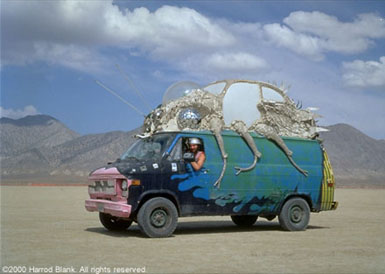
In 1995 I attended my first Burning Man, where one of the most surreal spectacles I witnessed was a large silver shark racing across the playa with teeth bared and tail flapping. This was Ripper the Shark, an art car made by Texas artist Tom Kennedy. Ripper and Tom resided at Art Car Camp, where I found myself spending afternoons chatting with the art car artists and helping to paint a car. The fledgling art car camp began a tradition on the playa, and in 2001, the camp, managed by art car czar Harrod Blank, swelled to 25 cars from Washington, Oregon, California, Arizona, Nevada, New Mexico, and Texas. Harrod is the creator of the Camera Van.
In addition to painted, decorated, and altered cars, the ranks of art vehicles on the playa have grown to include firetrucks, buses, bicycles, scooters, motorcycles, golf carts, and all manner of wheeled, mobile objects which serve as transport of some kind. One sees boats, pirate ships, rockets, living rooms, fish, ponies, insects, cats, couches, lobsters, giant heads, and flying saucers, among others. The perfectly flat and empty playa serves as a wonderful setting for the art cars, and the occasional art car parade is greatly enjoyed by participants. Because they are the only vehicles allowed to be driven on the playa, they are proliferating, but certain criteria must be met. Gluing a few tchotchkes on your car or covering it in glo-sticks does not an art car make. Your car must be approved by our Department of Mutant Vehicles and you must have a DMV sticker in order to drive it. Learn more about art vehicles on the playa.
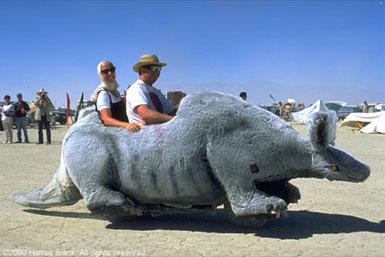
Art Cars and Burning Man
by Harrod Blank
Normally art cars are on the fringe and considered alternative and kooky. At Burning Man, however, art cars suddenly become cool, and more, they are integrated into the community and celebrated as part of the event’s identity. The art car artist is thus made to feel more like a hero than a freak, a part of the inside instead of on the outside.
Ever since 1994 I have attended the event in my art car “Oh My God!” and helped to organize the art car theme camp. Moved so much by the new imagery and cutting edge art, I embarked upon making a documentary film on 16mm. I am still working on it today focusing on this creative energy that brings us altogether. Certainly many people are attracted to the nudity and the fire and the overall spectacle of the event, and granted, I too revel in it all — but what really gives me a charge is the fresh, challenging, dynamic, and contemporary public art. Burning Man to me is like a giant adult rated show n’ tell, a smorgasbord of art, identity, and passion of which the art cars are a big part. Granted I am coming from a very artcar-centric point of view, but in my opinion art cars are symbols of the spirit of individuality and freedom which is what draws people to the event in the first place. The real difference between the art cars and Burning Man is that once the man is burned and everyone goes home, the art cars continue to carry the torch year round… and against the flow of traffic!
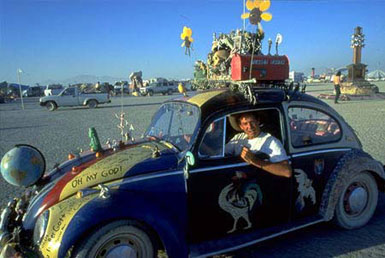
As long as the art cars have the right to be driven, to be mobile and given life, they will in turn give life to the event regardless of its size and location. It may not be apparent to the average viewer, but the art cars help to flip the definition of our sense of community and our values by placing artistic expression more at the top of the totem pole and manufactured unoriginal consumer images (cars) at the bottom where they belong. If only real life was like Burning Man in which only art cars were given permits to drive!
See Harrod’s Burning Man images at www.harrodblank.com.
Learn more about art cars at www.artcaragency.com.
The Art of Burning Man: an Illustrated Essay
By Darryl Van Rhey (1999)
“While some artists have never questioned the current marginal and passive status of art and are content to work within the reservation called the ‘art world,’ others have made conscious attempts over the last decade to combat the relentless commodification of their products and to reenter the ‘outside world.’ In the late ’60s, after a period in which most avant-garde art was drastically divorced from social subjects or effects, many artists became disgusted with the star system and the narrowness of formal ‘movements.’ They began to ask themselves larger questions. When they looked up from their canvas and steel, they saw politics, nature, history and myth out there.”
Lucy Lippard, Overlay (1983)
Avant-garde movements have historically originated among groups of artists whose work is devoted to new and experimental concepts that subvert institutional values. Such values are said to be marked by a concern for material interest and respectability, which inhibits expression. Any such regime, it’s held, is devoted to the status quo, to the preservation of appearances, and inevitably engenders an insincere and stultifying mediocrity of taste. It is the duty of the artist, as a member of a renegade class situated at the fringe of society, to challenge these philistine standards, thereby reclaiming the practice of art as a spiritual enterprise.
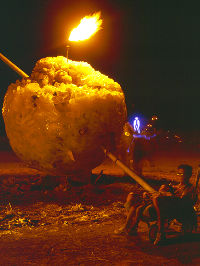
Judged by this standard, the avant-garde, in this latter part of the 20th Century, no longer appears to exist. Attempts to shock the middle class undoubtedly persist, but these actions, like so many other cultural elements of our contemporary scene, have been smoothly co-opted by a process of commodification. Madonna now affronts the bourgeoisie, as surely as Piss Christ and the concoctions of Jeff Koons, but such transgressive gestures are themselves merely artifacts of a marketing process. They do nothing to disturb the course of material interest, much less lead to any form of spiritual awakening. Art in America now originates within a system that is wholly institutionalized. The dead hand of bureaucracy is everywhere apparent, represented by a system of production which links art schools to an art industry — a complex of corporations, museums, and private dealers — that, in turn, controls the marketing apparatus that selects and distributes these privileged goods. Caught between the aridity of academia and the banality of this marketplace, it scarcely seems surprising that our art has lost vitality.
One minor chink remains, however, in the armor plating of this system, and it is found in the necessary concession that is made to “outsider” art. This novel category identifies art that is produced outside of the established system. It is, in practice, an extremely broad concept, including work produced within the unselfconscious vernacular traditions of folk art, “naive” work created by amateur or untrained artists, and contemporary popular productions, such as custom car decoration or graffiti art. These artists and their styles, once discovered by critics and academics, are appropriately bracketed by theoretic formulations and historical analysis. Transformed into a kind of intellectual property, this work becomes “art”, and may then assume the status of commodity within a market for “significant” work. That art might thrive, or even be said to exist, beyond the context of this system remains a moot point.

Nearly all of the art produced at Burning Man readily falls into the category of outsider art. Or rather, it fulfills the first requirement for inclusion in this category. It is frequently produced by unschooled amateurs who have little acquaintance with academic discourse. It is a “lay” art made popularly accessible to an ingenuous public. It has, to date, received only modest critical validation and it possesses little currency within the conventional marketplace. The work of many “serious” artists, who have exhibited their work in legitimating venues,
and who have devoted themselves over many years to their craft and calling, is certainly present in abundance at Burning Man. However, much of this work is burned in the course of the event and, most significantly, it is deliberately stripped of its normal marketplace context. The art of Burning Man, produced by amateur and professional alike, is created within and for a community, and, within this community, it is intended to be given away. This is work that’s generated by a way of life. It is an art, above all other things, that is devoted to social connection and, to understand its peculiar character, we must first consider how it is produced and the setting in which it is presented.
The social and economic world of Burning Man is created by gift giving. This forms a contrast to the “economy of scarcity” that prevails within the art world at large, in which a ceaseless competition for resources and recognition inevitably alienates artists from one another. The audience for art at Burning Man is superabundant, the venue represented by the open playa is virtually limitless, and acceptance of any work, regardless of accreditation, is unconditional. Moreover, these remarkable freedoms are counter-balanced by a disciplining challenge. The celebrated doctrine of “radical self-reliance,” by which participants are vested with complete responsibility for creating their personal visions within a severe natural environment, promotes a high degree of collaboration. Artists are simultaneously freed from their dependence on a validating system that controls their work and perpetually urged, as they assemble their resources, toward cooperation with others. This process, in fact, is directly abetted by the Burning Man Project. Utilizing the abundant resources of the Internet, it is possible to provide artists with a ready supply of volunteer aid. Furthermore, both the Burning Man event and the interconnective network formed by the Internet have been used to expose the work of artists to a larger and far more diverse public than is currently accessible within the self-limiting subculture formed by the established art world. It becomes possible for artists to directly market their work to interested individuals, thereby subverting the current marketplace system altogether. Burning Man, as a populist movement, has exposed thousands of participants to the uses of art who would otherwise be excluded by the social and economic constraints that currently oppress its practice.
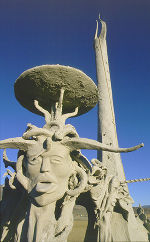
The next phase of this process occurs in the desert. From its inception, Burning Man has encouraged interactive strategies of presentation. This is art, to paraphrase project founder Larry Harvey, that convenes society around the creative act. Participants in Burning Man are urged to literally lead la vie Boheme — to struggle at the edge of physical survival while giving everything for self-expression. The interior gifts that constitute the artist’s talent become a currency of social exchange. Art at Burning Man does not merely attempt to break down barriers between audience and art form, and between creator and participant — a long-standing aim of avant-garde movements in our century. It seeks to become the central principle that generates both social interaction and the ordering architecture of civic space.
The result of this emphasis on the socially generative aspects of art has produced work that is marked by certain themes and expressive techniques. At a practical level, much of this art requires an action on the part of participants to achieve completion. It is often premised on fantasies and participatory scenarios which seduce the erstwhile audience for art into assuming an active and interpretive role that often places them in a relationship with fellow participants. This principle is most immediately evident in what are called “Theme Camps”. These live-in interactive installations have multiplied in recent years until they now line the main street of Black Rock City, extending in an uninterrupted series over more than one linear mile of civic real estate. Almost as prevalent are art-based conveyances. A city-wide ban on motorized vehicles allows but one exception: mobile art. This has led to the proliferation of many ingenious devices, ranging from elaborately decorated “Art Cars” to motorized couches, chairs and lamp stands. As radically accessible and self-created worlds, these installations bear a remarkable resemblance to web sites on the Internet. The image of the desert as an anologue of cyberspace — as an interactive, spontaneous and anti-hierarchic medium — has profoundly affected the aesthetic of Burning Man.
Furthermore, these strategies of engagement and interaction have deeply influenced the work of the many professional artists who contribute to the event. A monumental ice ball entitled Temporal Decomposition was fashioned at Burning Man 1997 by artist Jim Mason. This solid sphere, measuring 11 feet in diameter, represented a complex meditation on the processes of time. Embedded with an array of clocks and watches, it functioned, in concert with four frozen obelisks, as an enormous sundial. Gradually melting over a span of five days, this frozen mass embodied geologic process, evoking Time’s passage as a medium of transformation. Sited at a public crossroads, it invited parched participants to rub against it and consume its substance in the form of flavored snow cones. This same year saw the installation of Das Ammoniten Projekt, a metal and canvas structure by German artist Hendrik Hackl. Measuring 10-feet-high and 70 feet in diameter, this sculpture was fashioned in the semblance of a giant ammonite. Participants were allowed to enter this coiled construction, creeping forward by degrees until they slithered out a narrow aperture located at its center.
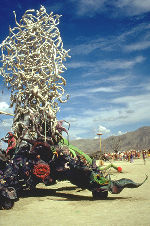
An equally participatory work by Dan Das Mann, installed in 1998, took the form of a 25-foot-tall tree constructed from copper pipes. Titled The One Tree, it simultaneously spouted fire, water and steam from its branches. It soon became a community bathing spa. In 1996 a large-scale assemblage was constructed from 88 pianos by artist Steve Heck. The Piano Bell enabled participants to generate sounds by stroking the strings of exposed instruments. Another interactive work, conceived by Larry Harvey, designed by sculptor Michael Christian and equipped by Dr. Aaron Wolf Baum with an interactive sound system, appeared in 1998. The Nebulous Entity functioned as an interactive performance platform designed for mobility. The 30-foot-tall sculpture was outfitted with five airplane wheels attached to supporting armatures, allowing participants to push it across the desert floor. Moving mysteriously through the night, it recruited involvement, generating spontaneous processions throughout the city.
Certain other techniques and thematic preoccupations also characterize the body of work Burning Man has produced, and these can be divided into basic genres. The first of these categories relates to the practice of appropriation. From an early date, Burning Man has been influenced by San Francisco’s machine art underground, a movement pioneered by Mark Pauline’s Survival Research Laboratories throughout the 80’s and 90’s. In recent years, many of its members have formed independent groups whose work appears at the festival. Notable practitioners include Kal Spelletich of the SEEMEN and industrial artist Christian Ristow. Appropriation is a central tenet of this work. Industrial technology is excerpted from its functional context and converted to a wholly aesthetic, and often spectacularly destructive, purpose. The work of Spelletich, Ristow and others will be featured this year at Burning Man at a “disassembly line” located at 9 o’clock upon the Wheel of Time. These practices form part of a specifically postmodern aesthetic, a willful deconstruction of the economic and industrial apparatus which carthartically redeems these tools for expressive use. A prime example is a performance installation entitled HELCO, which formed part of Burning Man’s annual themed art pageant in 1996.

This performance featured the work of both Spelletich and Ristow and was conceived as a broad burlesque upon the themes of mass production and consumption. The elaborately premised drama transformed participating members of the public into “souls” within a quarter-mile-long model of Dante’s Inferno. This same grotesque sensibility is apparent in The Sta-Puft Lady, produced for the event by Tim Kaulen. This huge inflated plastic doll was constructed from discarded advertising signage and tethered to the desert floor. Bloated, dismembered and unnervingly cute, this 20-foot deformity loomed over the event in 1997, like some ur-monster gleaned from Goya’s late and dark imaginings.
Reconnecting Art & Life
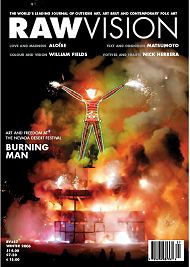
This essay was written by Ladybee in Winter of 2006, and published as the feature article of Issue 57 of Raw Vision, the world’s leading journal of outsider art.
Reconnecting Art & Life
Burning Man, an annual temporary community in the Black Rock Desert of Nevada, is the world’s largest outdoor art gallery, featuring nearly three hundred art installations scattered across a barren, prehistoric lake bed known as a playa. For one week late in August of each year, nearly 40,000 participants gather to create a vibrant city based on self-expression, survival, sharing, and radical self-reliance. Life in Black Rock City is characterized by collaborative interactive art-making, gift-giving, performance, and costuming. The making of art is encouraged; anyone can display whatever they’ve created without judgement, competition, or censorship. Art is a vital part of the city; it is virtually everywhere – on the open playa, in the camping area, in the center café, along the trash fence which marks the boundaries of the city, in the small participant-run airport, along the entrance road, and within a pavilion on which stands the Burning Man, a 40’ tall wooden figure that marks the center of the city, and is burned at the end of the event. The art is characterized by interactivity; it’s accessible, hands-on, and meant to be touched, climbed, and played with, providing intense, intimate experiences not usually available in gallery or museum settings.
Here, art is not viewed as the sole province of trained, educated specialists, as it is in the institutionalized world; it is part and parcel of everyday life for the citizens of Black Rock City, nearly all of whom produce objects for use and display during the event, from costumes and small items given out as gifts to large-scale art installations. Art-making in this way seems related to earlier societies, where decorating one’s possessions and making objects was a natural expression of belonging to a group, and a way of making daily life meaningful. At Burning Man, the do-it-yourself ethic is the community standard, and aesthetics are enthusiastically explored by everyone, not just artists.
Neither is art viewed as the work of the isolated individual; virtually all of the larger works at Burning Man are produced collaboratively, bringing artists, crews, and participants together in a rich, immersive and immediate experience. This kind of empathic social interaction through art-making generates community on the playa and beyond, as participants return to their homes and create their own regional events in the style of Burning Man. There are currently 65 regional groups worldwide. In addition, Burning Man’s sister organization, the Black Rock Arts Foundation, funds interactive art outside of the event, much of which is made by untrained artists. This unusual situation has inspired engineers, teachers, techno-geeks, scientists, community groups, doctors, graduate students, carpenters – all sorts of people who would not consider themselves artists – to make art, many for the first time.
Steve Heck is a piano mover from Oakland, California, who saves all of the piano parts he acquires in his work, storing them in his crowded warehouse. At Burning Man 1996 he built a two-story enclosure entirely from piano soundboards and casings – 88, to be exact – the number of keys on a piano. Participants continuously played the exposed strings of the soundboards.
From 1996 to 1999, Burning Man participants were treated to unconventional folk operas performed on elaborate, fanciful architectural fantasies built by San Franciscan Pepe Ozan. In the early 1990’s Pepe, born in Argentina and trained as a lawyer, started making playa mud lingams which functioned as chimneys. By 1996 these had evolved into complex structures with multiple towers and platforms upon which the operas took place, complete with an orchestra, a libretto, singers and costumed performers, and culminating in fire.
Anatomy of an Honorarium Grant Project
In the winter of 2001, David Biggs proposed to us a project related to the Maze area of our theme, The Seven Ages. The Hanged One was intended to be a contemplative meditation garden where one could ponder the issues related to the Justice, the stage of life which invites reflection on one’s past and decisions about one’s future. After the event, David sent us this final report, which we feel is a good anatomy of a Burning Man grant project. It illuminates the challenges and rewards of creating an installation for Burning Man, and shows how a project can engage participants at our event, and also effect groups of people beyond our immediate community.
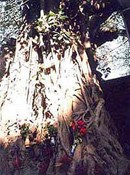 David writes:
David writes:
The inspiration for this piece came about with my experience in previous years and from objects encountered during my stay in Vietnam. I decided to create a small environment within which participants could both appreciate the surrounding desert environment and meditate upon their own questions in a quiet, peaceful space. I allied this piece with the theme art connected to the Maze as the stage of life in the Seven Stages known as “Reflection.” I found the tarot image of The Hanged One to be particularly useful as a thematic reference because of the card’s implication towards surrender towards higher wisdom and the Greater Being as well as the visual reference of a person hanging upside down from a tree in meditation.
 I modeled the tree after “cay da” or Banyan Tree from Viet Nam. This tree grows for several hundred years and offers shade and a common meeting place for people in a village. They are also planted outside temples and shrines because the spirit of this tree is believed to be a good, protective one. Particularly old trees are even honored with flowers and incense, and people living near the tree burn incense and pray to it for good luck and blessings.
I modeled the tree after “cay da” or Banyan Tree from Viet Nam. This tree grows for several hundred years and offers shade and a common meeting place for people in a village. They are also planted outside temples and shrines because the spirit of this tree is believed to be a good, protective one. Particularly old trees are even honored with flowers and incense, and people living near the tree burn incense and pray to it for good luck and blessings.
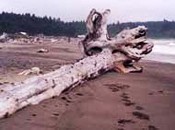 While living in Hanoi this past spring I also contracted the sewing of the lantern skins with a local upholsterer in the city’s old quarter. These 36 old streets once were the location for the 36 major trade guilds of the city from roughly 1200-1800. Today residents still come here though the guilds have changed. The particular street where my friend, Mr. Thanh, worked specialized in upholstery and repair of motorcycle seats. Mr. Thanh was particularly helpful in suggesting improvements to the lantern design and transport. I traveled to an outlying village to collect the rattan and bamboo used in the construction of the lanterns. Thanh and his friend helped me cut the lantern pieces to correct length and dimension. I’m also working to find Thanh’s daughter an appropriate hearing aid as she is deaf. In the course of drinking beer after the final work was completed, he told me how he is trying to find appropriate hearing aids so that his daughter may be able to go to school.
While living in Hanoi this past spring I also contracted the sewing of the lantern skins with a local upholsterer in the city’s old quarter. These 36 old streets once were the location for the 36 major trade guilds of the city from roughly 1200-1800. Today residents still come here though the guilds have changed. The particular street where my friend, Mr. Thanh, worked specialized in upholstery and repair of motorcycle seats. Mr. Thanh was particularly helpful in suggesting improvements to the lantern design and transport. I traveled to an outlying village to collect the rattan and bamboo used in the construction of the lanterns. Thanh and his friend helped me cut the lantern pieces to correct length and dimension. I’m also working to find Thanh’s daughter an appropriate hearing aid as she is deaf. In the course of drinking beer after the final work was completed, he told me how he is trying to find appropriate hearing aids so that his daughter may be able to go to school.
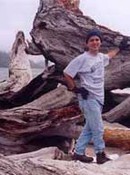 Upon returning to Seattle with the lantern load in June, I began looking for a Seattle-based source for the tree section. After one scouting trip and several hours of phone calls to organizations on the Olympic Peninsula, I found the Quileute Nation to be particularly receptive to my request. In exchange for a lantern and a promise to send them some pictures of the finished project, they allowed me to collect a vanload of logs to complete the piece. It was at this point that I saw coming together a unique aspect of the project, the trifold sources for materials from my three homes-Hanoi (lanterns), Olympic Coast (wood), Black Rock Desert (rocks).
Upon returning to Seattle with the lantern load in June, I began looking for a Seattle-based source for the tree section. After one scouting trip and several hours of phone calls to organizations on the Olympic Peninsula, I found the Quileute Nation to be particularly receptive to my request. In exchange for a lantern and a promise to send them some pictures of the finished project, they allowed me to collect a vanload of logs to complete the piece. It was at this point that I saw coming together a unique aspect of the project, the trifold sources for materials from my three homes-Hanoi (lanterns), Olympic Coast (wood), Black Rock Desert (rocks).
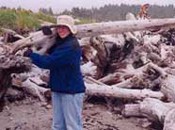 LadyBee was particularly helpful in sending me media packs to give the Quileute Nation upon my second collecting trip to La Push. Upon meeting members of the tribal council, I learned that to the Quileute and all coastal Salish peoples the red cedar is a tree with similar sacred values attached to it as the banyan tree in Vietnam. The red cedar is used to construct canoes, and canoes are used for construction of homes as well as all manner of canoes including racing and burial canoes. The trees washed up at St James island where I collected included hulking carcasses of 400 yr old trees such as this.
LadyBee was particularly helpful in sending me media packs to give the Quileute Nation upon my second collecting trip to La Push. Upon meeting members of the tribal council, I learned that to the Quileute and all coastal Salish peoples the red cedar is a tree with similar sacred values attached to it as the banyan tree in Vietnam. The red cedar is used to construct canoes, and canoes are used for construction of homes as well as all manner of canoes including racing and burial canoes. The trees washed up at St James island where I collected included hulking carcasses of 400 yr old trees such as this.
My sister was unable to attend the event this year but did fly down from Alaska to help my partner and I collect the wood. All in all, we collected about thirty logs such as this one weighing about 1.5 tons.






